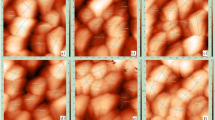Abstract
This paper reports the effect of heat treatment on the electronic activity of grain boundaries of polycrystalline silicon. The results obtained show that for the same concentration of doping, the arsenic doped films are more resistive and have less free carriers than boron doped films. The arsenic atoms have a greater tendency to segregate at the grain boundaries than boron atoms. We also noticed that the heat treatment before implantation reduces the number of trap carriers and the quantity of doping atoms at the grain boundaries. For low doping, the concentration of the free charge carriers improves after the heat treatment by 100 % and 23 % for arsenic and boron doping respectively.
Similar content being viewed by others
References
Zaidi B, Hadjoudja B, Felfli H, Chouial B, Chibani A (2011) Effet des traitements thermiques sur le comportement électrique des couches de silicium poly-cristallin pour des applications photovoltaïques. Revue de Métallurgie 108:443–446
Haddad A, Inokuma T, Kurata Y, Hasegawa S (2005) Characterization of Structure and Role of Different Textures in Polycrystalline Si Films. J Non-Cryst Solids 351:2107–2114
Hadjoudja B, Chibani A (2006) Modèle global pour la conduction électrique dans des couches de silicium polycristallin. Ann Chim Sci Mat 31:121–134
Yu B, Ju DH, Lee WC, Kepler N, King TJ, Hu C (1998) Gate Engineering for Deep-Submicron CMOS Transistors. IEEE Trans Elec Dev 45:1253–1262
Mahamdi R, Mansour F, Scheid E, Boyer BT, Jalabert L (2001) Boron Diffusion and Activation during Heat Treatment in Heavily Doped Polysilicon Thin Films for P + Metal-Oxide-Semiconductor Transistors Gates. Jpn J Appl Phys 40: 6723–6727
Zaidi B, Hadjoudja B, Felfli H, Chibani A (2011) Influence of doping and heat treatments on carriers mobility in polycrystalline silicon thin films for photovoltaic application. Turk J Phys 35: 185–188
Zaidi B, Hadjoudja B, Chouial B, Gagui S, Felfli H, Chibani A (2015) Hydrogenation Effect on Electrical Behavior of Polysilicon Thin Films. Silicon 7:275–278
Steffens S, Becker C, Zollondz JH, Chowdhury A, Slaoui A, Lindekugel S, Schubert U, Evans R, Rech B (2013) Defect annealing processes for polycrystalline silicon thin-film solar cells. Mater Sci Eng B 178:670–675
Zaidi B, Hadjoudja B, Chouial B, Gagui S, Felfli H, Magramene A, Chibani A (2015) Effect of Secondary Annealing on Electrical Properties of Polysilicon Thin Films. Silicon 7:293–295
Brotherton S D (1995) Polycrystalline silicon thin film transistor. Semicond Sci Tech 10:721–738
Lee KF, Ginnsons JF, Saraswat KC, Kamins TI (1979) Thin film MOSFET’s fabricated in laser-annealed polycrystalline silicon. Appl Phys Lett 35:173–175
Kamins T (2012) Polycrystalline silicon for integrated circuit applications. Kluver Academic Publishers, Massachusetts
Wong H (2002) Recent developments in silicon optoelectronic devices. Microelectron Reliab 42:317–326
Lifshitz N (1983) Solubility of implanted dopants in polysilicon: phosphorus and arsenic. J Elec Soc 130:2464–2467
Shibata T, Lee KF, Gibbons JF, Magee TJ, Peng J, Hong JD (1981) Resistivity reduction in heavily doped polycrystalline silicon using CW-laser and pulsed-laser annealing. J Appl Phys 52:3625–3632
Masetti G, Severi M, Solmi S (1983) Modeling of carrier mobility against carrier concentration in arsenic, phosphorus and boron doped- silicon. IEEE Trans Elec Dev ED30: 764–769
Author information
Authors and Affiliations
Corresponding author
Rights and permissions
About this article
Cite this article
Zaidi, B., Hadjoudja, B., Shekhar, C. et al. Dopant Segregation and Heat Treatment Effects on the Electrical Properties of Polycrystalline Silicon thin Films. Silicon 8, 513–516 (2016). https://doi.org/10.1007/s12633-015-9359-7
Received:
Accepted:
Published:
Issue Date:
DOI: https://doi.org/10.1007/s12633-015-9359-7




